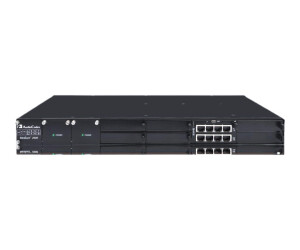

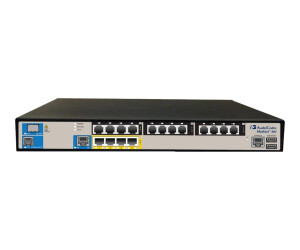


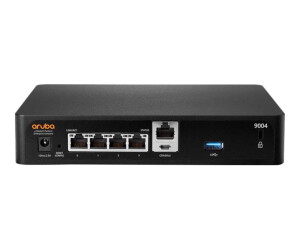
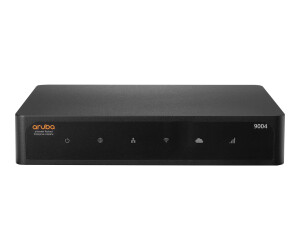
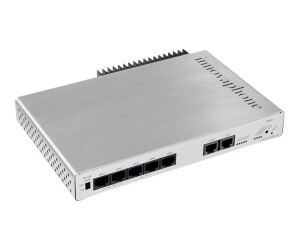
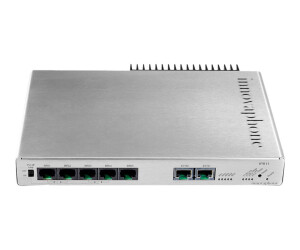

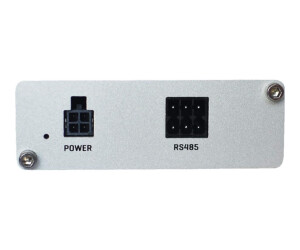











A device type "Gateway" is a central element in network architectures and serves as an interface between different networks or protocols. It facilitates the transmission of traffic between different networks by converting the protocols and formats of data packets when they are transferred from one network to another. Here is a detailed description of the device type "Gateway":
Definition and Functions: A gateway is a network device that acts as a translator or converter between different networks or protocols. It establishes the connection between different networks that typically use different communication protocols. The gateway operates at OSI Layer 7 (Application Layer) and can extend up to OSI Layer 4 (Transport Layer). It translates data packets and messages between different protocols to ensure smooth communication.
Functions of a Gateway:
Gateways are complex network components that fulfill a variety of important functions to enable seamless communication between different networks, systems, and protocols. The following functions are integral parts of how a gateway operates:
Protocol Translation: One of the fundamental functions of a gateway is protocol translation. In this process, data packets are converted from one protocol to another to enable communication between different networks. For example, a gateway could convert data from TCP/IP to HTTP to facilitate data transfer between a local network and the internet. This function is crucial for ensuring interoperability between different protocols.
Data Format Conversion: Gateways are also responsible for converting the data format of data packets. This ensures that the data can be properly understood and processed in the target system. Different networks often use different data formats. A gateway ensures that the data is appropriately transformed to enable smooth communication.
Address Translation: Address translation is another important function of gateways, especially in the context of Network Address Translation (NAT). This function allows multiple devices in a local network to connect to the internet via a single public IP address. The gateway translates the internal IP addresses of the devices into the public IP address when data packets leave the network and performs the reverse translation when the data packets return.
Security: Gateways often serve as security control points between different networks. They are equipped with security features that aim to prevent unauthorized access and threats. This can include the implementation of data filters, firewalls, and security checks. A gateway monitors the traffic and allows only authorized and secure data traffic to pass while blocking undesirable or suspicious activities.
Route Determination: Gateways also play a role in determining the optimal route for data packets between different networks. As routing nodes, gateways analyze the traffic and select the best path for data transmission. This is particularly important in large networks where data needs to be routed through multiple nodes and paths to ensure the most efficient transmission.
Gateways fulfill a variety of functions that are essential for seamless and secure communication between different networks and systems. Their ability to translate protocols, convert data formats, translate addresses, implement security measures, and determine routes makes them a crucial component in modern network architectures.
Example Application of a Gateway: Home Wi-Fi Router
An extremely common and practical example of a gateway's application is the home Wi-Fi router. This device acts as a bridge between the home network (Local Area Network, LAN) and the internet (Wide Area Network, WAN). The functionalities of a home Wi-Fi router highlight the essential role of gateways in modern communication technology. Here is a detailed explanation of how a home Wi-Fi router works:
1. Connection Between LAN and WAN: The home Wi-Fi router serves as a gateway that establishes a connection between the internal home network and the global internet. The LAN consists of various devices in the household, such as computers, smartphones, tablets, and other connected devices. The WAN represents the internet with all its remote servers, websites, and resources.
2. Protocol Translation and Address Translation: When data packets are sent from devices in the LAN towards the internet, the router translates the internal IP addresses of the devices into the public IP address recognized by the internet. This enables traffic between the two different addressing systems. The router performs this address translation using Network Address Translation (NAT).
3. Data Format Conversion: The data sent by devices in the LAN may have different data formats compared to the data formats used on the internet. The router ensures that the data packets are converted so that they can be understood and processed by the target systems on the internet.
4. Data Forwarding and Routing: A home Wi-Fi router also acts as a mediator that forwards data packets between the LAN and the internet. When a device in the LAN sends data to an external address, the router analyzes the destination address and forwards the data through the best available path to the corresponding destination on the internet.
5. Security Features: An important aspect of a home Wi-Fi router is security. The router monitors incoming and outgoing traffic and can implement firewall and security features to block unwanted or malicious activities. It can also protect devices in the LAN from potential threats by filtering traffic and blocking potentially harmful content.
6. Wireless Communication: In most cases, home Wi-Fi routers have wireless capabilities that allow devices in the LAN to connect wirelessly to the router. This wireless communication is enabled through radio waves, and the router acts as an access point, establishing wireless connections for mobile devices.
The home Wi-Fi router is an excellent example of the diverse functions of a gateway. It demonstrates how a gateway bridges between different networks, protocols, and addressing schemes, converts and manages traffic, and implements crucial security functions. Without this type of gateway, seamless communication between the home network and the internet would not be possible, and modern connected households would be greatly limited.
Types of Gateways:
Gateways are crucial components in networks that connect different systems, protocols, or network types. Depending on the specific requirements and goals of a network, there are various types of gateways:
Protocol Gateway: A protocol gateway is a type of gateway that enables communication between different protocols. It translates data packets from one protocol to another to ensure interoperability between different systems. For example, a protocol gateway could translate between TCP/IP and HTTP to ensure proper transmission of data between a web server and a backend database server.
Network Gateway: A network gateway connects different types of networks that may use different network architectures or protocols. A common example is the connection between a Local Area Network (LAN) and a Wide Area Network (WAN). The network gateway ensures efficient transmission of data between these networks.
Voice Gateway: A voice gateway facilitates communication between voice and data communication systems. It converts analog voice signals to digital data and vice versa. This type of gateway is particularly important for Voice-over-IP (VoIP) communication systems that transmit voice over IP networks.
Email Gateway: An email gateway connects different email systems. This can be helpful when businesses use different email platforms or when communication between different email domains is required. The email gateway translates email messages and ensures their proper delivery.
Firewall Gateway: A firewall gateway specializes in network security and protection against unauthorized access and threats. It acts as a security checkpoint and monitors traffic to ensure that only authorized and secure data pass through the network. The firewall gateway implements security policies and filters to fend off threats.
Each of these gateway types serves a specific function in the network environment. They enable seamless communication between different systems and contribute to interoperability, security, and efficiency. Choosing the right type of gateway depends on the network's requirements, the systems to be connected, and the desired functionalities.
Advantages of Gateways:
Interoperability: Gateways enable seamless communication between different networks and protocols that would not typically be directly compatible. This promotes interoperability and data exchange between different systems.
Protocol Translation: By converting data between different protocols, gateways facilitate communication between systems that use different communication standards. This is especially useful in global networks.
Data Format Conversion: Gateways can convert data packets into different formats to ensure they can be correctly processed by receiving systems. This is important when different networks use different data structures.
Security: Gateways can act as security control points, monitoring, filtering, and protecting traffic. They can implement firewall rules to block unauthorized access and fend off threats.
Address Translation: Through Network Address Translation (NAT), gateways can convert private IP addresses into public IP addresses, allowing multiple devices in a local network to connect to the internet through a single public IP address.
Scalability: Gateways facilitate connecting different networks, enhancing system scalability. New networks can be added without affecting the existing network structure.
Redundancy and Fault Tolerance: Setting up redundant gateways can achieve higher availability and fault tolerance. If one gateway fails, another can take over its function.
Disadvantages of Gateways:
Complexity: Setting up and managing gateways can be complex, especially when connecting multiple networks or protocols. Configuration errors can lead to malfunctions.
Latency: Using a gateway can introduce some latency, as data packets need to be converted and translated before being transmitted between networks. This can impact performance.
Single Point of Failure: If a gateway fails, it can result in a communication breakdown between networks. Adequate redundancy is necessary to prevent this.
Security Risk: Since gateways mediate traffic between networks, they can pose security risks if not properly secured. Insecurely configured gateways could allow unauthorized access.
Compatibility Issues: Improperly configured gateways or faulty translations can lead to compatibility issues, resulting in data loss or malfunctions.
Cost: Implementing and maintaining gateways can be expensive, both in terms of hardware and the required configuration and security work.
Throughput Limitations: The performance of a gateway can limit the throughput of traffic between networks, especially when complex protocol translations or security features are implemented.
Gateways provide essential functionality for communication between different networks and protocols. The benefits lie in interoperability, security, and scalability. The drawbacks primarily concern the complexity of configuration, latency, and potential security risks. It's important to carefully consider all aspects during the implementation and management of gateways to ensure optimal performance and security.
Conclusion: A gateway is a versatile network device that plays a crucial role in facilitating smooth communication between different networks and protocols. It enables network interoperability and ensures efficient and secure data transmission. While often working behind the scenes, the gateway is an indispensable element in modern network architectures.





| id | title | mpn | price | manufacturer |
|
from *
/ |

